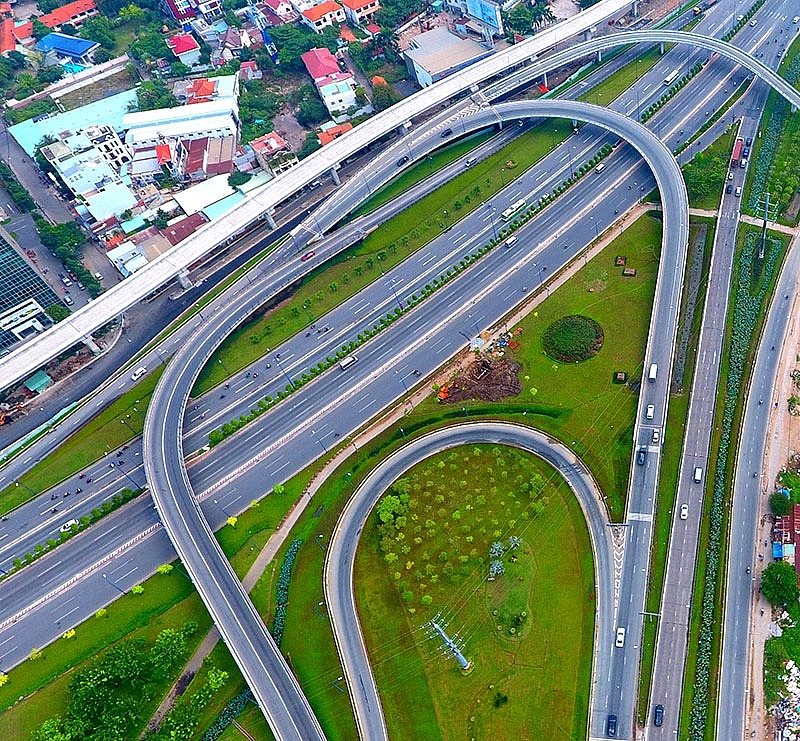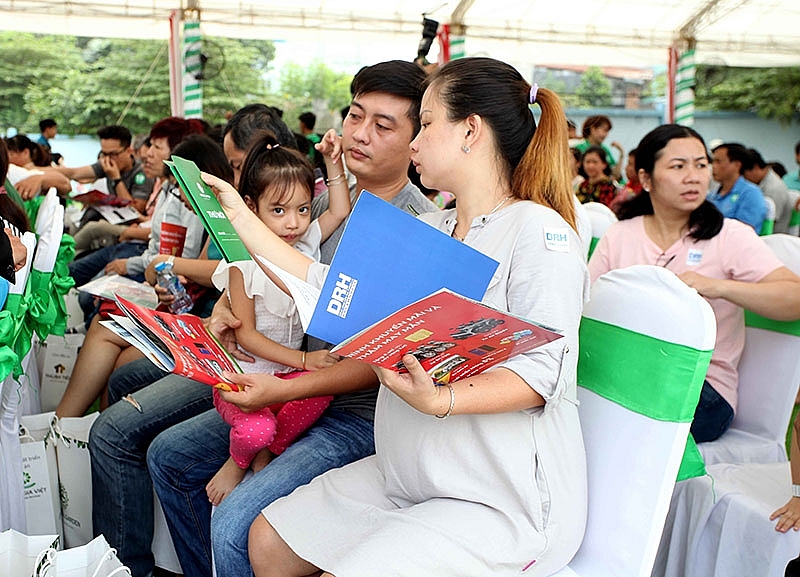East rises on back of infrastructure development
 |
| Huge investments have reached the infrastructure network of the eastern area of Ho Chi Minh City over the past few years |
City infrastructure boom
According to its general urban development strategy, Ho Chi Minh City will grow in all four points of the compass. However, the city’s infrastructure development policy seems to be more focused on the east, which has the advantages of “a gateway” connecting the entire southern region of Vietnam.
Most of Ho Chi Minh City’s key transportation projects pass through the east, such as Saigon River Tunnel, Vo Van Kiet Street, Thu Thiem Bridge, and Saigon 2 Bridge linking the city centre with districts 2 and 9 or Pham Van Dong Road connecting Tan Son Nhat International Airport with Thu Duc District.
Furthermore, Ho Chi Minh City-Long Thanh-Dau Giay Expressway also directly connects the eastern area of the city with Dong Nai. The Ben Thanh-Suoi Tien Metro project (Line 1) is planned to be put into operation in 2020, running from the east to the city centre.
Specifically, Ho Chi Minh City has recently adopted new policies to encourage businesses to invest in a series of transport infrastructure projects in the east. According to the Ho Chi Minh City Department of Transport, in the 2017-2018 period, three more important transport projects will be implemented including Ring Road 2 with total investment capital of over VND13.115 trillion ($577.75 million). In particular, two transport projects in the east are in urgent need and require the adoption of specific mechanisms to be completed soon. These include the sections from Phu Huu Bridge to Hanoi Highway and from Binh Thai intersection to Pham Van Dong Road.
After these projects are executed, the 69 kilometre-long Ring Road 2 will be thoroughly connected to establish a route linking the whole area of the east, all the way from Go Dua Bridge (National Highway 1, Thu Duc District) to Binh Phuoc junction (intersection with National Highway 13), Rach Chiec Bridge in District 9, and Phu My Bridge spanning the Saigon River between districts 7 and 2.
Recently, the real estate property market in the east has been re-energised by rumours of re-launching Rach Chiec Sports Complex. This is a series of Olympic-standard sports facilities covering an area of 180 hectares with a total estimated capital sum of VND34 trillion ($1.5 billion), which are being built to serve the SEA Games 31 in 2021.
Such breakthroughs in the infrastructure of the eastern area have completely changed the city skyline. At present, most real estate giants are developing their own large-scale projects in the east, such as Dai Quang Minh Real Estate Investment Corporation with Sala City; Vingroup with the Vincity project; Novaland Group with a series of projects in districts 2 and 9; Him Lam Land Corporation with Him Lam Phu Dong, Him Lam Phu An, and a 120-hectare project in District 2 which is expected to be launched in 2018. Besides, other developers including Thu Duc House, Khang Dien, Dat Xanh, Phuc Khang, Hung Thinh, and Nam Long all have major projects in the east expected to be announced in 2018.
According to Le Hoang Chau, chairman of the Ho Chi Minh City Real Estate Association, current developments show that the east will be the leading segment of the city’s real estate market in 2018 and the following years. In addition to the potential opportunities it might bring to real estate businesses, the east is dynamically attracting capital inflows from a number of leading global corporations, such as Japan, Korea, France, and the US, targeting other sectors.
 |
| A lot of young families choose properties in the east |
New price floors
Breakthroughs in infrastructure have led to the strong development of the real estate market in the eastern area, continuously elevating real estate prices there over the past few years. Nguyen Xuan Loc, general director of Techcom Real Corporation, said that while there was quite a large gap between land prices in central business districts (CBD) like Binh Thanh, Phu Nhuan, and District 3 and the eastern part of the city five years ago, prices in the east have pretty much caught up by now. In fact, land prices in districts 2 and Thu Duc have become much higher than those of the CBD.
| The increasing land prices in the east are understandable, seeing the dynamic development of transport infrastructure, which helps shorten the travel time from this area to the city centre. |
According to expert analysis, the increasing land prices in the east are understandable, seeing the dynamic development of transport infrastructure, which helps shorten the travel time from this area to the city centre.
As stated by Dinh Duy Trinh, general director of BVLand Corporation, for those in need of a suitable residential area for living, the eastern districts remain some of the most attractive options.
“At present, the pressure of overloaded urban transportation has made many people who used to live in the south or in Tan Phu, Tan Binh, Binh Tan, and Binh Chanh districts think about moving to the east,” he said.
According to a number of surveys, over the last few years, the liquidity of properties and housing prices in the east have been increasing consistently. Since the beginning of 2016, land prices in areas with convenient traffic conditions have seen the most remarkable increases of about 40-60 per cent. At many projects in districts 2, 9 and Thu Duc, which were launched a year ago, the price increases show no signs of stopping, while the demand is still substantial.
Take Moonlight Residences of Hung Thinh Corporation, which is situated in both Dang Van Bi and Dan Chu streets (Thu Duc District), as an example. At the end of 2016, the average selling price only ranged from VND55-65 million ($2,423-2,863) per square metre. To date, it has increased to VND80-90 million ($3,524-3,965). Still, there are no sellers on the market and the supply is extremely limited. Regarding Him Lam Phu Dong, the starting price announced by the developer at the end of 2016 was only VND23 million ($1,013) per sq.m. However, it has surged to VND35-40 million ($1,542-1,762) by now.
Similarly, some projects along Ho Chi Minh City-Long Thanh-Dau Giay Expressway have seen sharp increases in prices. For example, the average price of an apartment in Lakeview City of Novaland has risen from VND6 billion ($264,317) to VND7-8 billion ($308,370-352,422) per unit, while the price of a property in Merita Khang Dien has also increased by VND2 billion per unit on average since the beginning of 2016. Meanwhile, the average price of a property in Keppel Land’s Palm City has soared by approximately 40 per cent in just a few months after the project was launched to the market.
According to industry insiders, with its plentiful advantages and more to come in the future, along with the abundant land bank for development, the eastern area of Ho Chi Minh City will be the largest playground of the city’s real estate market in the coming time.
What the stars mean:
★ Poor ★ ★ Promising ★★★ Good ★★★★ Very good ★★★★★ Exceptional
Themes: Vietnam Property Outlook 2017
Related Contents
Latest News
More News
- Unlocking urban potential of smart cities (December 18, 2025 | 16:50)
- Green finance offers 'passport' for Vietnamese construction, building materials firms (December 15, 2025 | 08:00)
- Gamuda Land commit long-term investment (December 12, 2025 | 11:49)
- HITC ties up with Evolution to develop AI and hyperscale data centres in Vietnam (December 11, 2025 | 12:09)
- Real estate deals boom via high-profile names (December 08, 2025 | 11:32)
- Industrial segment shaped by M&As (December 08, 2025 | 08:00)
- The Privé sets the benchmark for luxury real estate (December 05, 2025 | 08:28)
- TD CASA and the rise of bespoke interior design in luxury living spaces (December 03, 2025 | 14:14)
- Lee Soo-man's Blooming Sky to build Gia Lai culture, sport, and entertainment complex (December 02, 2025 | 16:41)
- Sustainability in DNA of Keppel Vietnam's future urban development strategy (November 28, 2025 | 10:53)

 Tag:
Tag:




















 Mobile Version
Mobile Version